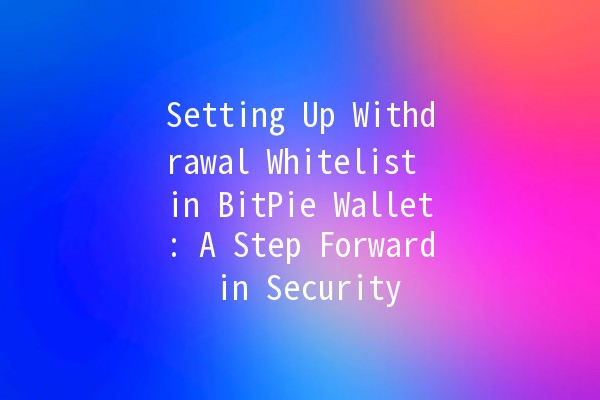




When it comes to managing cryptocurrencies, ensuring the safety of your digital assets is paramount. One of the most effective ways to enhance security is by setting up a withdrawal whitelist in your wallet. This article provides an indepth look at how to set up a withdrawal whitelist in the BitPie wallet, along with practical tips that can help you optimize your cryptocurrency management process.
Whitelisting is a security protocol that ensures a limited number of addresses can receive withdrawals from your wallet. When you set up a whitelist, any withdrawal requests can only be processed if the destination address is on your approved list. This greatly minimizes the risk of unauthorized transactions and adds an additional layer of security to your cryptocurrency holdings.
The growing number of cybersecurity threats makes it increasingly important for individuals and organizations to protect their digital assets. Here are some of the main reasons to set up a withdrawal whitelist:

To get started with the BitPie wallet, you first need to create an account if you don't already have one. Go to the BitPie website or download the wallet app and follow these steps:
Download the App: Make sure you’re downloading the official app from a legitimate source to avoid scams.
Create a Wallet: Follow the prompts to create a new wallet, which will involve generating a seed phrase. Keep it safe and secure.
Secure Your Account: Set up twofactor authentication (2FA) to help secure your wallet further.
Once your account is created and secured, log into your BitPie wallet using your credentials. This is where you will be able to manage your assets, including setting up the withdrawal whitelist.
After logging in, look for the 'Security' settings in your wallet. In this section, you will find options related to automatic withdrawals, whitelisting, and other security features.
Once you are in the security section, look for the withdrawal whitelist option. Click on it to access the interface where you can manage your whitelisted addresses.
This is the crucial step where you will define the addresses from which you will accept withdrawals. Enter the addresses of trusted wallets you own or are certain are safe. You can typically add multiple addresses based on your needs.
After you have added the addresses, make sure to save the changes. You may need to verify your identity through an email confirmation or 2FA code before changes take effect.
As with any security measure, regularly reviewing your whitelist is critical. If you no longer need a specific address, or if you wish to add a new one, make those changes accordingly. Periodic reviews can help you maintain an uptodate security posture.
Now that you know how to set up a withdrawal whitelist, here are some productivityenhancing tips that can help you manage your BitPie wallet more effectively:
Using a reliable password manager ensures that all your passwords, including that of your BitPie wallet, are secure, unique, and easily accessible. This increases your overall security and simplifies your login process.
Utilizing notifications can keep you informed about any transactions made from your BitPie wallet. Setting up alerts for any activity, including failed withdrawal attempts, can help you react promptly to unauthorized actions.
Regularly backing up your wallet ensures that you can easily recover your assets in case of loss or device failure. The backup usually involves saving your wallet's seed phrase and keeping it in a safe place.
If your wallet allows for it, consider setting transaction limits on withdrawals to mitigate risks in the event of unauthorized access. This can serve as a failsafe that limits how much can be withdrawn at a time.
Staying informed about the latest security trends, threats, and best practices in cryptocurrency can significantly enhance your ability to protect your wallet. Consider following reputable blogs, forums, and conferences dedicated to digital asset security.
A withdrawal whitelist is a security feature that allows only specific, preapproved addresses to receive withdrawals from your wallet, thereby enhancing its security by limiting potential unauthorized transactions.
You can verify your whitelist's functionality by attempting to withdraw to an address that is not whitelisted. The transaction should fail, indicating that the feature is active.
Yes, you can remove addresses from your whitelist through the security settings of your wallet. It’s advisable to remove addresses you no longer use or trust.
If you lose access to your wallet, recovery usually relies on your seed phrase. Make sure you have it securely backed up, as losing it may result in losing access to your cryptocurrency.
This depends on the specific wallet service provider. BitPie may have a limit, so always check the wallet’s terms or documentation if you’re unsure.
It's good practice to review your withdrawal whitelist regularly, ideally every few months or after any significant transaction. Keeping your whitelist updated ensures optimal security.
Incorporating these strategies into your cryptocurrency management routine in BitPie will not only bolster your security but also enhance your overall productivity. Embrace the advantages of whitelisting and take a proactive stance toward safeguarding your digital assets.